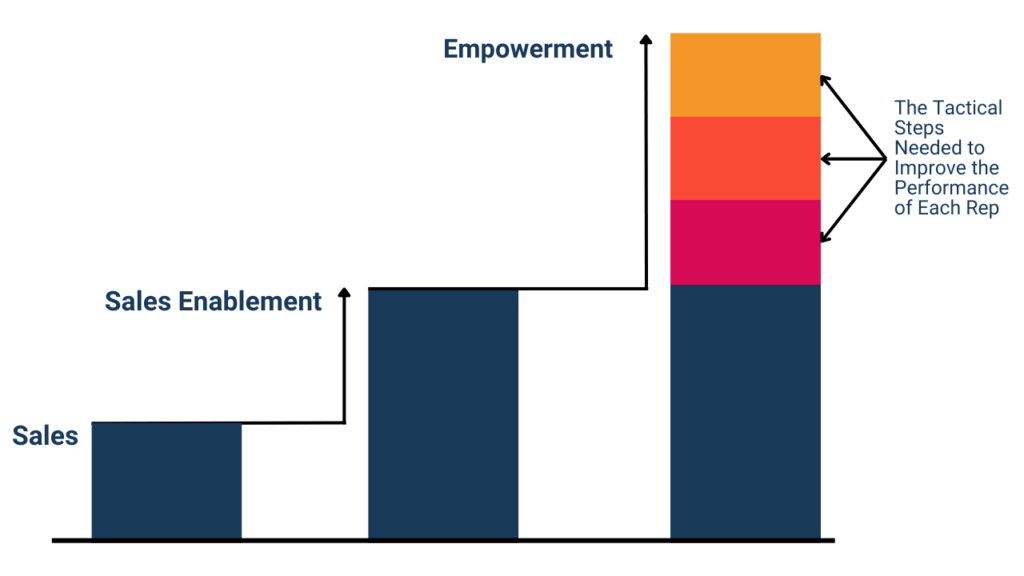A few years ago, sales teams were crushing quota and nearly every SaaS company’s ARR was going crazy – leading many companies to invest heavily in sales enablement.
At the time, the purpose of sales enablement teams was primarily to support sales reps and give them the tools they needed to be successful – while taking care of the kinds of admin tasks that would slow reps down (and plan quarterly Sales Kick Off’s too).
Fast forward to today, and things look… Bleaker. With somewhere between 20-30% of reps currently hitting their quota and revenue teams experiencing layoffs across the board, enablement’s purpose has changed.. Keeping reps up to date on trainings isn’t enough anymore, and in order to continue supporting sales reps, the enablement function needs to shift.
In this blog, we’re discussing sales empowerment and why it needs to be the focus for enablement teams in 2023. Check out the video below, or keep reading to get the scoop:
Is Enablement Still Working?
In the Salesforce Guide to Sales Enablement written back in 2022, they said that “Sales enablement means training your reps to sell. You coach them, educate them with content and certifications, and bring them together at events like sales kickoffs.”
And to be honest, when the market was good, that was enablement’s job. Keeping the sales team going with trainings, battlecard reviews and kick off events.. But, participating in an hour-long training isn’t enough to help reps hit quota in this market, they need more.
Many enablement teams are being reduced, or cut altogether, because although the economy and market have changed, many teams continue to do the same things. The problem is that giving reps the tools they need to do their job better, doesn’t necessarily work if reps don’t know what to do. The old ways of enablement assume that reps knew how to sell and be successful, but as the market has changed that might not be true anymore.
So if traditional sales enablement is no longer making sales reps successful, what should enablement teams be focused on?
What is Sales Empowerment?
First off – enablement vs. empowerment, what’s the difference? Let’s check it out:
The action of giving someone the authority or means to do something.
Authority or power given to someone to do something.
In the context of sales, empowerment goes further than enablement and addresses the gap between where your reps are, and where they need to be. At a high level, in order for enablement teams to be providing value, they need to be making the reps better. Traditional enablement focuses on giving sales the tools and trainings they need to keep selling. Empowerment goes a step further and addresses gaps in performance, and works to solve them in order to help sales reps continue to sell, even as the market changes.
“Empowerment is a sustainable way of providing support in order that the person becomes increasingly self-supporting (and can even come to support others), while enablement is merely short-term help so something gets done.”
Brainz Magazine, 2023
Empowerment involves looking deeper into the sales process and understanding fundamentally where there are gaps in sales rep knowledge. Selling looks different than it did a few years ago, and it’s the enablement team’s job to figure out where reps are falling short, and how they can help them to get better– we call this process empowerment.
Now we understand there needs to be a shift, but changing up the entire enablement function can sound like a daunting task. Let’s walk through what the transition from enablement to empowerment looks like in 3 steps.
Making The Shift From Enablement to Empowerment
Stage 1: Enablement
In this stage, as an enablement manager, you are taking your sales reps as they are and trying to make their days easier. You schedule the trainings that you know they should be doing, review battlecards and make sure they have everything they need to continue selling.
The aim of enablement in this stage is really just to follow the lead of the sales team, which only works if the sales team knows what they’re doing. But, as we discussed, this no longer works because reps don’t have the same confidence and understanding of the market like they used to.
Stage 2: Identifying the Gaps
With the understand that your reps are less confident than they used to be, you can begin to identify where there are gaps for each of your reps. For example, maybe your reps are consistently stalling out at the second prospect meeting. You can figure out what they are lacking, and what skills or knowledge they are missing. And, although performance hasn’t changed at this point, you at least understand what the problem is.

Stage 3: Start Empowering
Now that you know current enablement isn’t working, and have identified the gaps, you can take this a step further and begin to empower reps by addressing those gaps and providing trainings. The enablement function can begin to take more of a leadership position and help reps not only do their job, but empower them to do it better.
Moving from enablement to empowerment requires you to have a better understanding of what is holding your reps back, and then taking the steps to help them improve. By making this change, the value of the enablement function can skyrocket and rep performance can improve.
Shifting to what reps need
In conclusion, there is nothing wrong with enablement and there’s nothing special about empowerment. But in 2023, you need to be focused on empowering your reps to be as good as they can be and not only enabling reps to be as functional or as high-performing.




